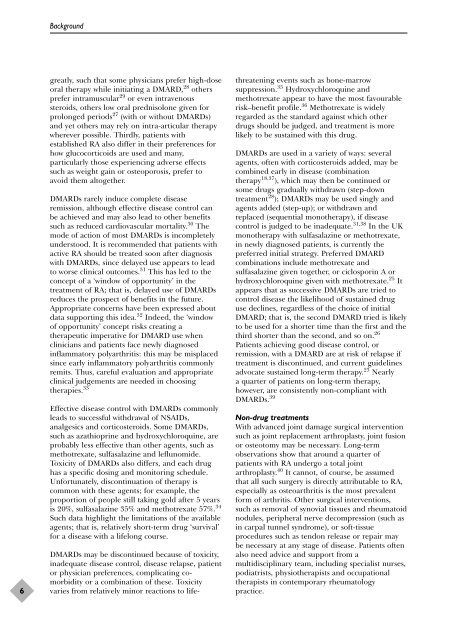A systematic review of the effectiveness of adalimumab
A systematic review of the effectiveness of adalimumab
A systematic review of the effectiveness of adalimumab
Create successful ePaper yourself
Turn your PDF publications into a flip-book with our unique Google optimized e-Paper software.
6<br />
Background<br />
greatly, such that some physicians prefer high-dose<br />
oral <strong>the</strong>rapy while initiating a DMARD, 28 o<strong>the</strong>rs<br />
prefer intramuscular 29 or even intravenous<br />
steroids, o<strong>the</strong>rs low oral prednisolone given for<br />
prolonged periods 27 (with or without DMARDs)<br />
and yet o<strong>the</strong>rs may rely on intra-articular <strong>the</strong>rapy<br />
wherever possible. Thirdly, patients with<br />
established RA also differ in <strong>the</strong>ir preferences for<br />
how glucocorticoids are used and many,<br />
particularly those experiencing adverse effects<br />
such as weight gain or osteoporosis, prefer to<br />
avoid <strong>the</strong>m altoge<strong>the</strong>r.<br />
DMARDs rarely induce complete disease<br />
remission, although effective disease control can<br />
be achieved and may also lead to o<strong>the</strong>r benefits<br />
such as reduced cardiovascular mortality. 30 The<br />
mode <strong>of</strong> action <strong>of</strong> most DMARDs is incompletely<br />
understood. It is recommended that patients with<br />
active RA should be treated soon after diagnosis<br />
with DMARDs, since delayed use appears to lead<br />
to worse clinical outcomes. 31 This has led to <strong>the</strong><br />
concept <strong>of</strong> a ‘window <strong>of</strong> opportunity’ in <strong>the</strong><br />
treatment <strong>of</strong> RA; that is, delayed use <strong>of</strong> DMARDs<br />
reduces <strong>the</strong> prospect <strong>of</strong> benefits in <strong>the</strong> future.<br />
Appropriate concerns have been expressed about<br />
data supporting this idea. 32 Indeed, <strong>the</strong> ‘window<br />
<strong>of</strong> opportunity’ concept risks creating a<br />
<strong>the</strong>rapeutic imperative for DMARD use when<br />
clinicians and patients face newly diagnosed<br />
inflammatory polyarthritis: this may be misplaced<br />
since early inflammatory polyarthritis commonly<br />
remits. Thus, careful evaluation and appropriate<br />
clinical judgements are needed in choosing<br />
<strong>the</strong>rapies. 33<br />
Effective disease control with DMARDs commonly<br />
leads to successful withdrawal <strong>of</strong> NSAIDs,<br />
analgesics and corticosteroids. Some DMARDs,<br />
such as azathioprine and hydroxychloroquine, are<br />
probably less effective than o<strong>the</strong>r agents, such as<br />
methotrexate, sulfasalazine and leflunomide.<br />
Toxicity <strong>of</strong> DMARDs also differs, and each drug<br />
has a specific dosing and monitoring schedule.<br />
Unfortunately, discontinuation <strong>of</strong> <strong>the</strong>rapy is<br />
common with <strong>the</strong>se agents; for example, <strong>the</strong><br />
proportion <strong>of</strong> people still taking gold after 5 years<br />
is 20%, sulfasalazine 35% and methotrexate 57%. 34<br />
Such data highlight <strong>the</strong> limitations <strong>of</strong> <strong>the</strong> available<br />
agents; that is, relatively short-term drug ‘survival’<br />
for a disease with a lifelong course.<br />
DMARDs may be discontinued because <strong>of</strong> toxicity,<br />
inadequate disease control, disease relapse, patient<br />
or physician preferences, complicating comorbidity<br />
or a combination <strong>of</strong> <strong>the</strong>se. Toxicity<br />
varies from relatively minor reactions to life-<br />
threatening events such as bone-marrow<br />
suppression. 35 Hydroxychloroquine and<br />
methotrexate appear to have <strong>the</strong> most favourable<br />
risk–benefit pr<strong>of</strong>ile. 36 Methotrexate is widely<br />
regarded as <strong>the</strong> standard against which o<strong>the</strong>r<br />
drugs should be judged, and treatment is more<br />
likely to be sustained with this drug.<br />
DMARDs are used in a variety <strong>of</strong> ways: several<br />
agents, <strong>of</strong>ten with corticosteroids added, may be<br />
combined early in disease (combination<br />
<strong>the</strong>rapy 18,37 ), which may <strong>the</strong>n be continued or<br />
some drugs gradually withdrawn (step-down<br />
treatment 28 ); DMARDs may be used singly and<br />
agents added (step-up); or withdrawn and<br />
replaced (sequential mono<strong>the</strong>rapy), if disease<br />
control is judged to be inadequate. 31,38 In <strong>the</strong> UK<br />
mono<strong>the</strong>rapy with sulfasalazine or methotrexate,<br />
in newly diagnosed patients, is currently <strong>the</strong><br />
preferred initial strategy. Preferred DMARD<br />
combinations include methotrexate and<br />
sulfasalazine given toge<strong>the</strong>r, or ciclosporin A or<br />
hydroxychloroquine given with methotrexate. 25 It<br />
appears that as successive DMARDs are tried to<br />
control disease <strong>the</strong> likelihood <strong>of</strong> sustained drug<br />
use declines, regardless <strong>of</strong> <strong>the</strong> choice <strong>of</strong> initial<br />
DMARD; that is, <strong>the</strong> second DMARD tried is likely<br />
to be used for a shorter time than <strong>the</strong> first and <strong>the</strong><br />
third shorter than <strong>the</strong> second, and so on. 26<br />
Patients achieving good disease control, or<br />
remission, with a DMARD are at risk <strong>of</strong> relapse if<br />
treatment is discontinued, and current guidelines<br />
advocate sustained long-term <strong>the</strong>rapy. 23 Nearly<br />
a quarter <strong>of</strong> patients on long-term <strong>the</strong>rapy,<br />
however, are consistently non-compliant with<br />
DMARDs. 39<br />
Non-drug treatments<br />
With advanced joint damage surgical intervention<br />
such as joint replacement arthroplasty, joint fusion<br />
or osteotomy may be necessary. Long-term<br />
observations show that around a quarter <strong>of</strong><br />
patients with RA undergo a total joint<br />
arthroplasty. 40 It cannot, <strong>of</strong> course, be assumed<br />
that all such surgery is directly attributable to RA,<br />
especially as osteoarthritis is <strong>the</strong> most prevalent<br />
form <strong>of</strong> arthritis. O<strong>the</strong>r surgical interventions,<br />
such as removal <strong>of</strong> synovial tissues and rheumatoid<br />
nodules, peripheral nerve decompression (such as<br />
in carpal tunnel syndrome), or s<strong>of</strong>t-tissue<br />
procedures such as tendon release or repair may<br />
be necessary at any stage <strong>of</strong> disease. Patients <strong>of</strong>ten<br />
also need advice and support from a<br />
multidisciplinary team, including specialist nurses,<br />
podiatrists, physio<strong>the</strong>rapists and occupational<br />
<strong>the</strong>rapists in contemporary rheumatology<br />
practice.
















